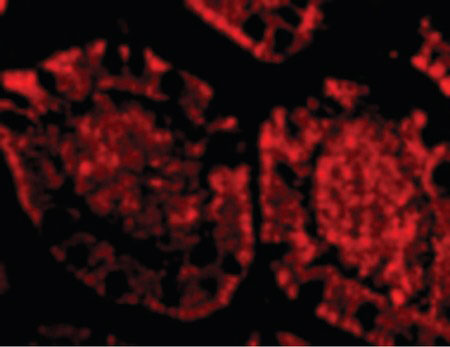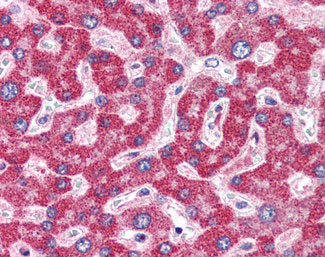ZBP1 Antibody (C-Terminus)
Rabbit Polyclonal Antibody
- SPECIFICATION
- CITATIONS
- PROTOCOLS
- BACKGROUND

Application
| WB, IHC-P, IF, E |
|---|---|
| Primary Accession | Q9H171 |
| Reactivity | Human, Mouse, Rat |
| Host | Rabbit |
| Clonality | Polyclonal |
| Calculated MW | 46kDa |
| Dilution | IHC-P (5 µg/ml), WB (0.5-1 µg/ml), |
| Gene ID | 81030 |
|---|---|
| Other Names | Z-DNA-binding protein 1, Tumor stroma and activated macrophage protein DLM-1, ZBP1, C20orf183, DLM1 |
| Reconstitution & Storage | Short term 4°C, long term aliquot and store at -20°C, avoid freeze thaw cycles. Store undiluted. |
| Precautions | ZBP1 Antibody (C-Terminus) is for research use only and not for use in diagnostic or therapeutic procedures. |
| Name | ZBP1 {ECO:0000303|PubMed:16876127, ECO:0000312|HGNC:HGNC:16176} |
|---|---|
| Function | Key innate sensor that recognizes and binds Z-RNA structures, which are produced by a number of viruses, such as herpesvirus, orthomyxovirus or flavivirus, and triggers different forms of cell death (PubMed:32200799). ZBP1 acts as an essential mediator of pyroptosis, necroptosis and apoptosis (PANoptosis), an integral part of host defense against pathogens, by activating RIPK3, caspase-8 (CASP8), and the NLRP3 inflammasome (By similarity). Key activator of necroptosis, a programmed cell death process in response to death- inducing TNF-alpha family members, via its ability to bind Z-RNA: once activated upon Z-RNA-binding, ZBP1 interacts and stimulates RIPK3 kinase, which phosphorylates and activates MLKL, triggering execution of programmed necrosis (By similarity). In addition to TNF-induced necroptosis, necroptosis can also take place in the nucleus in response to orthomyxoviruses infection: ZBP1 recognizes and binds Z-RNA structures that are produced in infected nuclei by orthomyxoviruses, such as the influenza A virus (IAV), leading to ZBP1 activation, RIPK3 stimulation and subsequent MLKL phosphorylation, triggering disruption of the nuclear envelope and leakage of cellular DNA into the cytosol (PubMed:32200799). ZBP1-dependent cell death in response to IAV infection promotes interleukin-1 alpha (IL1A) induction in an NLRP3- inflammasome-independent manner: IL1A expression is required for the optimal interleukin-1 beta (IL1B) production, and together, these cytokines promote infiltration of inflammatory neutrophils to the lung, leading to the formation of neutrophil extracellular traps (By similarity). In addition to its direct role in driving necroptosis via its ability to sense Z-RNAs, also involved in PANoptosis triggered in response to bacterial infection: component of the AIM2 PANoptosome complex, a multiprotein complex that triggers PANoptosis (By similarity). Also acts as the apical sensor of fungal infection responsible for activating PANoptosis (By similarity). Involved in CASP8-mediated cell death via its interaction with RIPK1 but independently of its ability to sense Z-RNAs (By similarity). In some cell types, also able to restrict viral replication by promoting cell death-independent responses (By similarity). In response to Zika virus infection in neurons, promotes a cell death-independent pathway that restricts viral replication: together with RIPK3, promotes a death- independent transcriptional program that modifies the cellular metabolism via up-regulation expression of the enzyme ACOD1/IRG1 and production of the metabolite itaconate (By similarity). Itaconate inhibits the activity of succinate dehydrogenase, generating a metabolic state in neurons that suppresses replication of viral genomes (By similarity). |
| Cellular Location | Cytoplasm. Nucleus. Note=Mainly cytoplasmic (PubMed:16876127, PubMed:16990255). Accumulates in the nucleus in response to influenza A virus (IAV) infection: senses IAV defective viral genomes RNA in the nucleus (By similarity). {ECO:0000250|UniProtKB:Q9QY24, ECO:0000269|PubMed:16876127, ECO:0000269|PubMed:16990255} |
| Tissue Location | Highly expressed in lymphatic tissues including lymph node, leukocytes, tonsil, bone marrow and spleen (PubMed:11842111). Expressed to a lesser extent in thymus, lung and liver (PubMed:11842111). |

Thousands of laboratories across the world have published research that depended on the performance of antibodies from Abcepta to advance their research. Check out links to articles that cite our products in major peer-reviewed journals, organized by research category.
info@abcepta.com, and receive a free "I Love Antibodies" mug.
Provided below are standard protocols that you may find useful for product applications.
Background
Participates in the detection by the host's innate immune system of DNA from viral, bacterial or even host origin. Plays a role in host defense against tumors and pathogens. Acts as a cytoplasmic DNA sensor which, when activated, induces the recruitment of TBK1 and IRF3 to its C-terminal region and activates the downstream interferon regulatory factor (IRF) and NF-kappa B transcription factors, leading to type-I interferon production. ZBP1-induced NF-kappaB activation probably involves the recruitment of the RHIM containing kinases RIPK1 and RIPK3 (By similarity).
References
Rothenburg S.,et al.Nucleic Acids Res. 30:993-1000(2002).
Heil O.,et al.Submitted (JUN-2005) to the EMBL/GenBank/DDBJ databases.
Ota T.,et al.Nat. Genet. 36:40-45(2004).
Deloukas P.,et al.Nature 414:865-871(2001).
Mural R.J.,et al.Submitted (SEP-2005) to the EMBL/GenBank/DDBJ databases.
If you have used an Abcepta product and would like to share how it has performed, please click on the "Submit Review" button and provide the requested information. Our staff will examine and post your review and contact you if needed.
If you have any additional inquiries please email technical services at tech@abcepta.com.













 Foundational characteristics of cancer include proliferation, angiogenesis, migration, evasion of apoptosis, and cellular immortality. Find key markers for these cellular processes and antibodies to detect them.
Foundational characteristics of cancer include proliferation, angiogenesis, migration, evasion of apoptosis, and cellular immortality. Find key markers for these cellular processes and antibodies to detect them. The SUMOplot™ Analysis Program predicts and scores sumoylation sites in your protein. SUMOylation is a post-translational modification involved in various cellular processes, such as nuclear-cytosolic transport, transcriptional regulation, apoptosis, protein stability, response to stress, and progression through the cell cycle.
The SUMOplot™ Analysis Program predicts and scores sumoylation sites in your protein. SUMOylation is a post-translational modification involved in various cellular processes, such as nuclear-cytosolic transport, transcriptional regulation, apoptosis, protein stability, response to stress, and progression through the cell cycle. The Autophagy Receptor Motif Plotter predicts and scores autophagy receptor binding sites in your protein. Identifying proteins connected to this pathway is critical to understanding the role of autophagy in physiological as well as pathological processes such as development, differentiation, neurodegenerative diseases, stress, infection, and cancer.
The Autophagy Receptor Motif Plotter predicts and scores autophagy receptor binding sites in your protein. Identifying proteins connected to this pathway is critical to understanding the role of autophagy in physiological as well as pathological processes such as development, differentiation, neurodegenerative diseases, stress, infection, and cancer.




